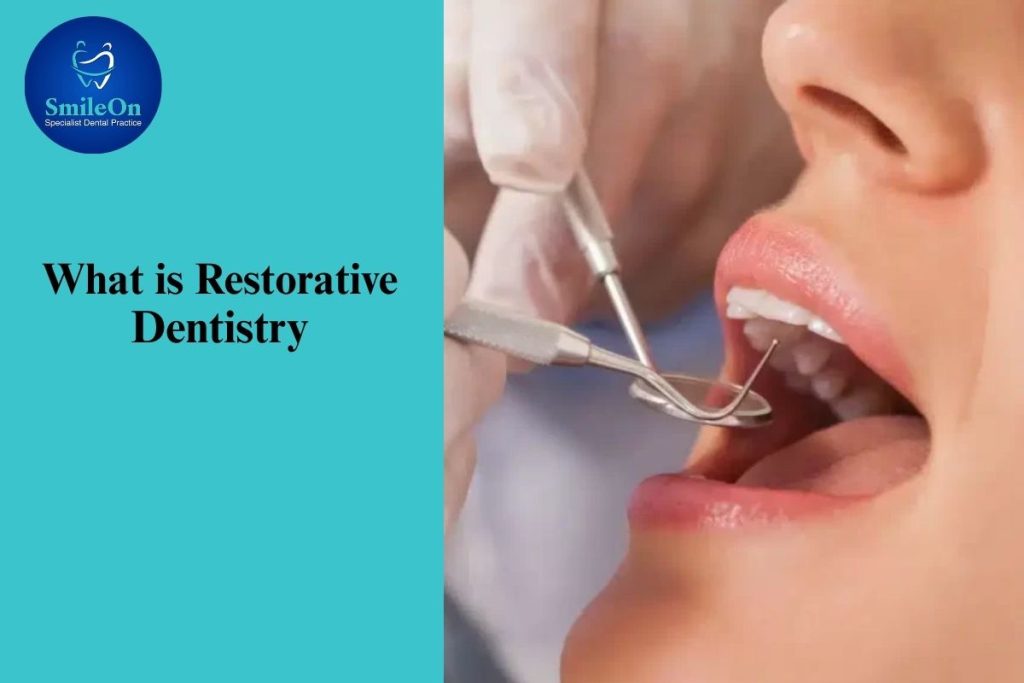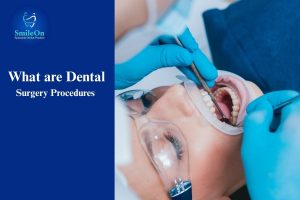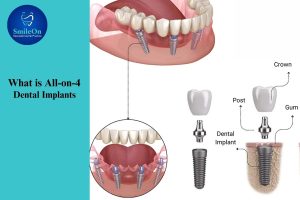A healthy smile means more than just a beautiful feature; it is necessary for eating, speaking, and overall well-being.
But tooth decay, injury and age can all leave a person with damaged or missing teeth, compromising the way they look and how much they can chew. This is where restorative dentistry becomes very important.
Restorative dentistry focuses on repairing and reconstructing the natural cosmetic and functional form of teeth. Whether you need a basic filling, a crown, partial dentures or full-mouth rehabilitation, your restorative dentist works to restore and maintain not only the appearance of your smile but also overall oral health.
Table of Contents
ToggleImportance of Restorative Dentistry
Restorative dentistry is a type of oral health care that specializes in diagnosing and treating problems with the teeth due to damage, decay, or loss. The primary purpose is to bring proper functioning and appearance back to your teeth so you can bite, speak, and smile naturally once again.
A restorative dentist will rely on a mix of preventative, corrective and cosmetic interventions to reconstruct your natural smile. They help to restore a good look as well as functionality, and can be necessary in order to avoid subsequent dental issues like tooth movement, bone loss or gum disease.
Simply put, restorative dentistry is about fixing what’s broken and replacing what’s gone so your mouth stays healthy and functional long into the future.
Common Restorative Dentistry Procedures
A restorative dentist may perform several procedures that are intended to fix, rebuild, and replace teeth. Here is an explanation of the most common types of restorative dentistry:
Dental Implants:
Implants are one of the finest restorative treatment options. They substitute missing teeth with an artificial root that is implanted into the jawbone (usually titanium). After the healing, a crown or bridge is then attached. All-on-4 implants appear and work just like one’s natural teeth, providing a permanent and secure option.
For focused treatment with implants, you can see prosthodontist services, they are experts who specialize in creating and fitting dental appliances such as crowns, bridges and dentures.
Dental Fillings:
Fillings are one of the simplest and most common dental restoration processes. They’re also used to treat cavities if they’re due to decay. The dentist cuts away the decay and then fills the space with some type of material, like composite resin or amalgam. To accommodate your tooth’s natural shade, composite fillings are a tooth-colored material that naturally merges with the rest of your teeth.
Dental Crowns:
When a tooth is weakened or damaged beyond hope of repair by filling, our team can preserve its structure by capping it with a crown (or cap). Porcelain, ceramic or metal can be used to make crowns. These procedures not only safeguard your teeth but can also enhance their appearance and position.
Teeth crowns can be particularly helpful following a root canal treatment or in the event of large fillings that become inadequate.
Dental Bridges:
A dental bridge fills in one or more missing teeth by “bridging” the space with false teeth. The bridge is supported by crowns on nearby natural teeth or implants. It will bring back chewing function and keep adjacent teeth from drifting.
Root Canal Treatment:
A root canal is required when a tooth’s inner pulp becomes infected or inflamed. The general dentist takes out the diseased tissue, sterilizes the area, and fills it with a filling. Usually, a crown is used after the root canal treatment to protect the treated tooth.
Dentures:
Dentures are devices that can be taken in and out of one’s mouth, which serve as replacements for groups of missing teeth. These are bespoke so that they fit your mouth comfortably and help you eat and speak as normal. Artificial teeth today appear natural, and implants can be used for added support.
Inlays and Onlays:
When the cavity is too big for filling and too small for a crown, the dentist recommends this treatment. Inlays sit inside the cusps of your tooth (the bumps), and onlays cover one or more cusps. They are a long-lasting, accurate and natural-looking complement to your own teeth.
Besides this, if you are curious about the dental professionals who administer these procedures, you can read about the various types of dentists here.
Benefits of Restorative Dentistry
The major benefits of restorative dentistry are:
- Better Oral Function: Gives you the ability to eat, chew and talk comfortably.
- Improved Looks: Returns your smile to a more natural look, restoring confidence.
- Protection: Restoration prevents ongoing damage to tooth decay and or structural problems.
- Good Oral Health: Helps in preserving the strength of your jawbone and health of gums, particularly after losing teeth.
- Long-Lasting: A lot of dental restorations can keep going a long time with the right maintenance.
When Do You Need a Restorative Dentistry Specialist?
You should contact a restorative dentistry specialist if you have:
- Teeth broken down, chipped or decayed
- Missing teeth
- Old and damaged dental restorations
- Trouble chewing or speaking normally
- Continual toothache or sensitivity.
Early treatment isn’t just about saving a tooth. This is to the end of preventing those more costly dental treatments.
Caring for Your Dental Restorations
Once restorations are finished, it is important to ensure that the process is successful for years to come:
- Maintain a clean space between restorations.
- You should not chew any hard foods or pieces of ice.
- Get regular restorative dental care.
- Keep up on your professional cleanings every 6 months.
With proper care, it will stay beautiful and healthy for decades to come!
FAQs
What is another name for restorative dentistry?
Prosthodontics is another term that is frequently associated with restorative dentistry, especially if prosthetics such as crowns, bridges, dentures and implants are involved in replacing or restoring missing teeth.
What is the difference between cosmetic and restorative dentistry?
Both have the goal of enhancing your smile, but the concerns of restorative dentistry center on treating damaged or missing teeth to repair function and optimize oral health. On the other hand, cosmetic dentistry improves the look of your teeth, gums and smile using procedures such as whitening and veneers.
How long does tooth restoration last?
The expected duration of life for a dental restoration also varies based on the type of restoration placed and how well it is maintained. However, fillings generally last five to ten years, with crowns and bridges lasting between 10-15 years or longer. Dental implants, if they are taken care of properly, will last a lifetime.
Conclusion
Restorative dentistry is a vital and necessary part of modern dental care, helping to return your teeth to their original form and function. This can range from simple fillings to more advanced implant procedures, but these services can help you reclaim your confidence and a gorgeous smile that will last.
If one or several of those teeth have been damaged, or if you are missing some (or many!) of them, then wait no longer.
Schedule a consultation with one of SmileOn’s restorative dentistry specialists. Contact us for more information on which treatment is right for you.






